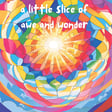Become a Creator today!Start creating today - Share your story with the world!
Start for free
00:00:00
00:00:01

Slice #5: Vastness and Scale
In this solo episode of A Little Slice of Awe and Wonder, the host reflects on the concept of vastness—not just in physical size, but across systems, history, and time. From the source code behind modern technology to the civilizational layers of ancient inventions like rice cultivation, we explore how everything is built on deep foundations.
support the show: https://buymeacoffee.com/goyama
Transcript
Introduction to Awe and Wonder
00:00:22
Speaker
What's up fellow humans, and welcome back to a little slice of awe and wonder. Today's a short one. I'm back solo today, and I just thought I'd share a few thoughts I've been having this week about one of the core aspects of awe, and that is vastness, and along with that idea, and the idea of scale.
00:00:39
Speaker
And not just in the sense of physical space, like when we look up at the stars or down into a canyon, you know, I'm thinking about the classic video, Powers of Ten, which if you haven't seen, you should totally check out. But this is also vastness across multiple dimensions, you know, across systems, across time, across
Evolution of Technology
00:00:55
Speaker
history.
00:00:55
Speaker
Recently I had to give this webinar on computer science and speech therapy and so I had to briefly touch on the history of computers which I know absolutely nothing about so I had to do a little digging and it really left me with this sense of awe of you know what we use today, which is so far removed from the origins of computers. So the idea for a computer actually came from punch cards that were used in the textile industry to make clothes. So they would run these punch cards through a machine to make different patterns in the thread. And in 1822, really not that long ago, if you think about it, Charles Babbage, he theorized that you could use these punch cards in a machine.
00:01:37
Speaker
to do calculations. Then finally, this is a a long time after, but in 1943, IBM built the first electromechanical computer. So they replaced these punch cards with electromechanical switches that read on or off. So this is another concept that's at the basis of all computers is at their very core computers are just reading on so that one or off that's a zero so that's what's called binary you've probably heard of it this before so all computers are doing are reading ones and zeros at the the kind of foundational level in 1945 the University of Pennsylvania they ah built this computer called the ENIAC so not so long ago
00:02:17
Speaker
There's this computer that it took up the size of an entire room. The switches, the electro-mechanical switches were replaced by vacuum tubes. So for all the the guitarists out there, these are the tubes that they use for tube amps. And so these were, so they're either in the on or the off position. There's 18,000 of these tubes in this big room and they had to be manually programmed with switches.
00:02:40
Speaker
every time you had to do a new calculation you had to reset all the plugs and they've got really funny pictures of all these people in this room pulling out the different switches and trying to make one calculation happen and you had to have this whole team of people so fast forward From tubes, they got smaller. They started using transistors. So if you've heard of the transistor radio, it's what they put in there. And they got smaller and smaller to tiny circuit boards. And now the transistors are integrated on computer chips. And so just for, I guess, a little detail about scale, an iPhone 15 has 19 billion transistors. hey Whoa, that's crazy. So it has a lot of processing power. just Just a couple of centuries ago, computers were nothing more than an idea.
Interconnected Systems: Technology and Civilization
00:03:25
Speaker
And now, look, we've built these systems of unimaginable complexity. Systems so intricate that, you know we you know, I tap on my phone screens, it's swipe left or right, and I can instantly summon information from anywhere in the world about anything.
00:03:40
Speaker
um you know the graphical interfaces that we use that feel so intuitive, so easy, just like magic. Behind all of this simplicity lie layers of you know kind of source code. So you think of the you know the programmer who's building this code, who's built on the code of of earlier people who are building on machine code. So there's this intricate, deeply layered system of programming and design.
00:04:06
Speaker
And we, you know, I don't ever think about this when I tap and swipe, but we're really building on these foundations of binary logic, transistors and decades of technological innovation. Each piece of this puzzle had to be meticulously developed by all of these minds working together, building upon one another's discoveries. And so that's how we can get here.
00:04:31
Speaker
But just like computers have a source code, there's there's a whole civilizational source code. So this is the code that's been built layer by layer through human ingenuity, culture, and more ancient technologies. So you know take something like rice cultivation. It's a technology that existed for thousands and thousands of years. And today, it's a foundational layer of the food industry. so when I eat a frozen meal from Trader Joe's, I'm not just eating the food in front of me, I'm participating in this enormous, complex system of interconnected layers. So if we continue the kind of computer analogy, there's the person who assembled my, you know, shawarma bowl, like the UX designer, maybe, who creates the user interface for an app. Then there's the person who cooks the ingredients, kind of like the the coder. They're the ones who work with the raw materials.
00:05:23
Speaker
combine them into something functional, something delicious. And finally, there's the person who grew the fruit, the farmer, who's kind of like maybe the hardware maker in this analogy. So without them, none of the rest would be possible. So this layered, civilizational source code, this system, is really a form of scale. And it's just as awe-inspiring as that you know the crazy code that's running our devices. And and not only that, it spans generations thousands of years of human effort and invention.
Time: Geological and Human History
00:05:55
Speaker
So from the invention of agriculture to modern logistics, yeah this code has been continuously refined and expanded and it allows us to live in this world of convenience and complexity and all of these amazing things that we get to see every day.
00:06:12
Speaker
And then, you know, this type of vastness, this depth goes across multiple dimensions. So we can talk about, for example, geological vastness. You know, the kind of scale time-wise is millions, billions of years on the earth. So, you know, we were just talking about the scale of computers, let's say, and their development. But think about the layers of the earth, which have these layers and layers of of sediment and rock and cooled lava.
00:06:39
Speaker
that each kind of record a whole epoch of the Earth's past. Every step you take, every breath is is built on this bedrock of of geological time. From the Earth's perspective, even the human history, like our history as as a species, is like a you know blink of an eye.
00:06:58
Speaker
And depending on your scale of time, you can really find different types of depth and and different types of vastness. And so, you know, obviously human history is a vast landscape. It's a different kind of layering from geological strata. But, you know, we have built these cultural, philosophical, technological tools that are kind of like these cultural layers, like the layers of the the earth.
00:07:23
Speaker
So every invention, every piece of art, every philosophical idea is like a layer of sediment that forms the ground that we stand on today. So the light bulb, for example, it seems so simple now, but think about the the centuries of trial and error, the countless minds that contributed to understanding electricity and light.
00:07:42
Speaker
And now what we do with it, we light houses. There's all these things that we use it for. In the same way you can consider breakthroughs in neuroscience, how we've discovered different parts of the brain that handle very specific functions like language, for example, or the evolution of mathematics. We're living in this vast web of interconnected ideas, inventions, and cultural progress.
00:08:03
Speaker
And so it reminds me of this is ah a famous poem that gets quoted everywhere, but William Blake's famous lines to see a world in a grain of sand and heaven in a wildflower hold infinity in the palm of your hand and eternity in an hour.
00:08:19
Speaker
So I feel like in this poem, Blake was capturing this idea of vastness too. How we can hold infinity in in small, everyday things because there's this
The Role of Art and Imagination
00:08:29
Speaker
connectedness. And, you know, a grain of sand, for example, it's not just a grain of sand, it's the product of billions of years of a geological process, you know, of wind and water breaking down mountains. it's It's tied to these vast systems of time and space, just like we are. And so just to share a ah quick, another moment of awe, this idea really came to life for me when I visited the Nelson Atkins Museum of Art in Kansas City last weekend. And just looking at the art there, each piece was, it felt like it was carrying the weight suddenly of these thousands of years of human creativity. They were showing all these exhibits from different parts of our history, and I just couldn't help but think about how many layers of history that we're standing on.
00:09:10
Speaker
how much human effort, trial, and error, and imagination are woven into everything that we see and experience today.
Reflection on Vastness and Interconnectedness
00:09:16
Speaker
So you know when we talk about On Wonder, it's not just about looking at the the stars or the Grand Canyon, though those are definitely awe-inspiring. It's also about recognizing the vastness of the scale of systems, from the systems that power our technology to the the deep time of Earth's history. We're part of this. We're in this vast, intricate,
00:09:39
Speaker
reality. And the more we look, the more we realize how really connected all of these layers are. So maybe just take a moment today and think about you know the the layers that are beneath your feet, the systems, the histories, the ideas that brought you to this very moment. Because I think when you do, you'll you'll find that you're not just standing in in one place. You're connected to that vast, ancient sense of awe and wonder.
Conclusion and Farewell
00:10:07
Speaker
So until next time, keep seeking out those little slices of awe and wonder in your life. Take care. I'll see you next time.



















